HOW TO ADMINISTER INSULIN PROPERLY
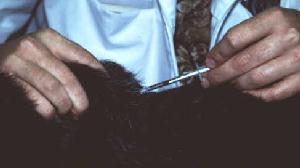
Improper handling or administration of insulin is one of the most common
reasons why some dogs seem difficult to regulate. Below is a list of helpful
hints. Coming soon we will have a video showing proper administration technique.
Keep insulin refrigerated except when in use. The vial should be stored
in a cooler with an ice pack when traveling, even for just a few hours.
Use syringes which match the concentration of insulin used.
To mix insulin, gently roll the vial between the palms of your hands
until well mixed. DO NOT SHAKE (Coming soon -
a hyperlink to video clip #1) OR ROUGHLY AGITATE THE VIAL under any
circumstances; this breaks apart the
insulin molecules and may render the insulin ineffective or at best
unpredictable in its activity.
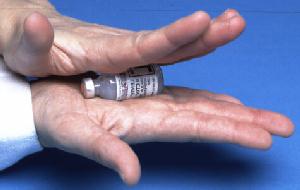
Insert the needle into the rubber port of the insulin vial while the
mixed vial is held inverted. Withdraw gently, applying
constant, even suction until a volume greater than the actual dose
required is aspirated into the syringe. Still maintaining
the vial in its inverted position, depress plunger of syringe to expel
any bubbles or excess insulin back into the vial until
the proper dose remains in the syringe. If large bubbles are
present in the syringe, depress the plunger and evacuate the contents gently
back into the vial and re-initiate withdrawal as above, but being
more gentle and aspirating more than previously. DO NOT RIGOROUSLY
AGITATE OR CONCUSS THE SYRINGE (Coming soon - a hyperlink to video
clip #2) IN AN EFFORT TO MAKE BUBBLES “RISE TO THE TOP” TO EVACUATE.
Instead, a very gentle tap may be sufficient. If not, depress the
contents of the syringe back into the vial and begin again. It is not essential
to evacuate every tiny bubble, particularly if the dose is greater than
10 units.
Keep in mind that it may be easier and more accurate to administer
smaller doses (<10 units) in smaller volume syringes such as 1/4
cc (for 25 units or less), 1/3 cc (for 30 units or less) or 1/2 cc
(for 50 units or less) syringes. It is well documented, in fact,
that marked overdoses occur when small doses (<5 units) are administered
with 1 cc U-100
syringes.
The volume of insulin drawn up should be measured from where the rubber
part of the plunger contacts the insulin, not
the other side where the rubber is attached to the rest of the plunger.
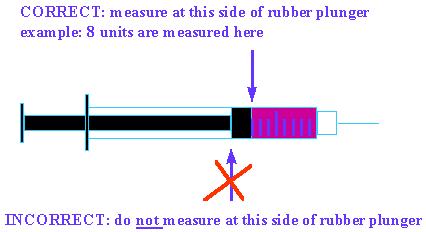
When treating the newly diagnosed diabetic pet, it is helpful to ask
your veterinarian to shave several small spots
(Coming soon - a hyperlink to video clip #3) over the back so that
you can actually see the needle enter the skin. This prevents “intra-fur”
(Coming soon - a hyperlink to video clip #4) or in-the-fur injections that
often occur when first
learning how to administer insulin. It is also helpful
to lift, or “tent” the skin up and inject at an angle almost parallel to
the backbone into the small triangle formed by the “tent”. It
is not unusual to penetrate one side of the tented skin and go right through
and out the other side of the skin, causing another “intra-fur” injection
that will obviously not control blood sugar levels. Penetrating the
skin more toward the base of the “tent” will help to insure that the tip
of the needle in under, and not through the skin on the other side.
Proper Injection Technique Picture Below
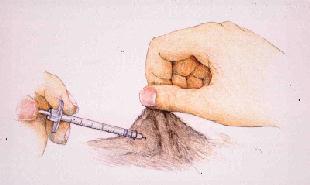
Improper Injection Technique
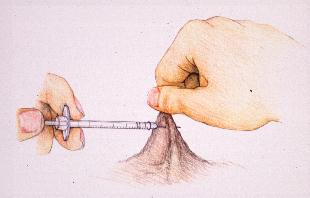
|
![]()





